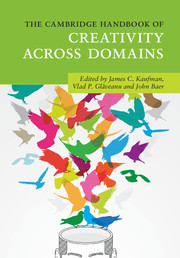Book contents
- The Cambridge Handbook of Creativity Across Domains
- The Cambridge Handbook of Creativity Across Domains
- Copyright page
- Dedication
- Contents
- Figures
- Tables
- Contributors
- Acknowledgments
- Part I Creativity and Domain
- Part II Creativity in the Traditional Arts
- 5 The Creativity of Literary Writing
- 6 Creativity in the Visual Arts
- 7 The Creation and Aesthetic Appreciation of Architecture
- 8 Photography and Creativity
- 9 The Constricted Muse
- 10 Musical Creativity
- 11 Dance
- Part III Creativity in the Sciences
- Part IV Creativity in Business
- Part V Newer Domains for Creativity Research
- Part VI Creativity in Everyday Life
- Part VII Conclusion
- Index
- References
6 - Creativity in the Visual Arts
from Part II - Creativity in the Traditional Arts
Published online by Cambridge University Press: 15 September 2017
- The Cambridge Handbook of Creativity Across Domains
- The Cambridge Handbook of Creativity Across Domains
- Copyright page
- Dedication
- Contents
- Figures
- Tables
- Contributors
- Acknowledgments
- Part I Creativity and Domain
- Part II Creativity in the Traditional Arts
- 5 The Creativity of Literary Writing
- 6 Creativity in the Visual Arts
- 7 The Creation and Aesthetic Appreciation of Architecture
- 8 Photography and Creativity
- 9 The Constricted Muse
- 10 Musical Creativity
- 11 Dance
- Part III Creativity in the Sciences
- Part IV Creativity in Business
- Part V Newer Domains for Creativity Research
- Part VI Creativity in Everyday Life
- Part VII Conclusion
- Index
- References
Summary
In this chapter, we review research on creativity with visual art, and, specifically, how this has been addressed within the psychology of art. We begin with a brief review of the history of psychology of art and the unique challenges associated with studying artistic creativity and expression. We then review current creativity studies that touch on art making and that focus on techniques and methods that provide the foundation for current research. We conclude with a consideration of important questions that hold particular intrigue for future study, such as questions related to artistic development, approaches to assessing art making, and the artistic brain.
- Type
- Chapter
- Information
- The Cambridge Handbook of Creativity across Domains , pp. 80 - 109Publisher: Cambridge University PressPrint publication year: 2017
References
- 12
- Cited by



